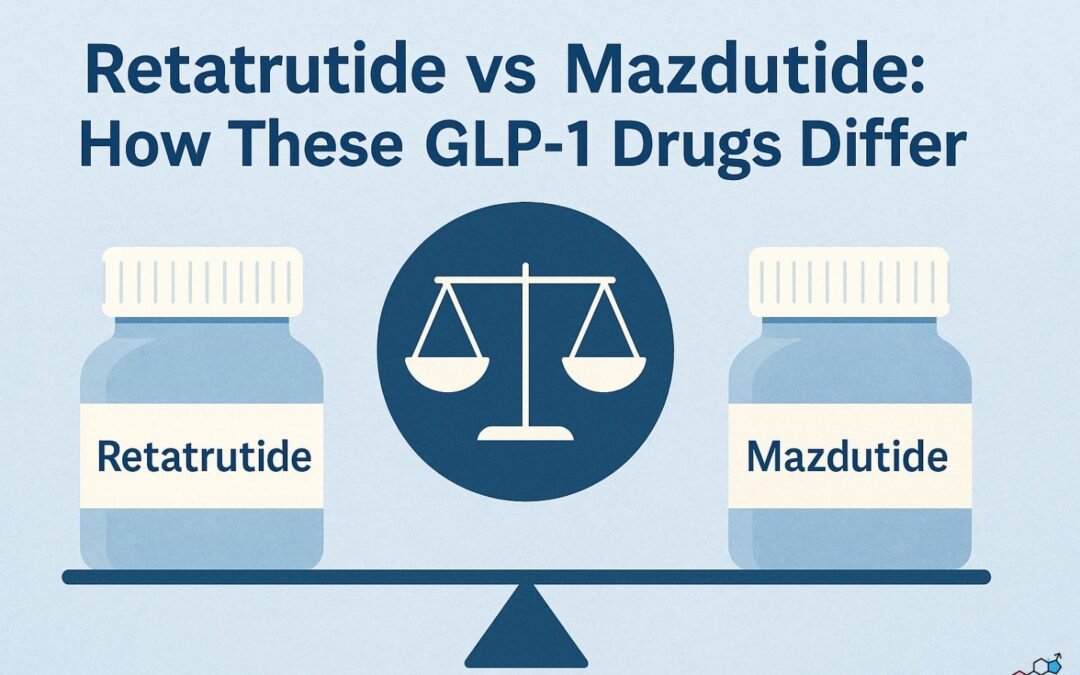The evolution of GLP-1-based therapies has introduced new options that go far beyond glucose control. Two investigational drugs, Retatrutide and Mazdutide, are generating attention for their unique mechanisms and promising data in obesity and type 2 diabetes.
They’re not just upgrades of what’s already on the market. They approach metabolic regulation differently. If you’re a clinician, patient, or researcher looking for clarity on how they compare, here’s a clear, in-depth look from a clinical and pharmacological standpoint.
1. Mechanisms of Action
Retatrutide: Triple Receptor Strategy
Retatrutide is designed to activate three key hormone receptors: GLP-1, GIP, and glucagon. This approach aims to engage more of the metabolic system at once.
- GLP-1 activation helps stimulate insulin release, curb appetite, and slow digestion.
- GIP activity supports insulin response and may enhance fat metabolism in a way that’s distinct from GLP-1.
- Glucagon receptor stimulation increases energy expenditure and may help reduce liver fat.
This combination gives Retatrutide a broader scope, targeting multiple angles of metabolic dysfunction. The rationale is to produce more comprehensive outcomes in both weight loss and metabolic improvement.
Mazdutide: Dual-Targeted Efficiency
Mazdutide, by contrast, sticks with dual receptor activation: GLP-1 and glucagon. The absence of GIP makes it a simpler molecule pharmacologically, but not necessarily less effective depending on the clinical use case.
- GLP-1 works the same way here: appetite regulation, improved insulin secretion, and delayed gastric emptying.
- Glucagon receptor activation is thought to promote fat breakdown and increase energy burn.
This dual mechanism may make Mazdutide more tolerable for some, while still offering real impact on weight and glucose control.
2. Clinical Efficacy
Weight Loss Outcomes
Retatrutide has shown some of the most substantial weight loss data seen to date.
- At 24 weeks, weight reductions reached 17.5%.
- By 48 weeks, that increased to 24.2% in some participants.
Those numbers put it in a different tier, potentially offering even more weight loss than tirzepatide. These are early findings, but they’ve been consistent across studies so far.
Mazdutide has also shown meaningful reductions, though less dramatic.
- A 6 mg weekly dose led to average weight loss of 11.3% at 24 weeks.
- That’s still a significant result, particularly in people with type 2 diabetes where weight loss can be harder to achieve.
Both drugs are effective, but Retatrutide currently shows the greater effect size in reducing body weight.
Blood Sugar and HbA1c Control
Both drugs improve glycemic markers, but Retatrutide again appears to be more potent.
- In clinical trials, Retatrutide lowered HbA1c by up to 2.02%.
- It also improved fasting glucose and overall insulin sensitivity.
Mazdutide produced reliable reductions in HbA1c as well, particularly in people with established type 2 diabetes. The dual mechanism still offers a significant improvement, just not as dramatic as what’s been seen with Retatrutide so far.
Liver Fat and Lipid Profile
Both drugs also appear to support liver health, which is especially relevant for patients with metabolic-associated fatty liver disease.
- Retatrutide led to notable reductions in liver fat content, suggesting it could have future utility in treating steatosis or NASH.
- Mazdutide, in its trials, improved triglyceride levels and showed reductions in uric acid, which may be relevant for patients with metabolic syndrome or gout risk.
3. Side Effect Profiles
Gastrointestinal Issues
The most common side effects for both drugs are related to the digestive system. These include:
- Nausea
- Diarrhea
- Vomiting
- Constipation
In general, these effects are dose-dependent and more common during the first few weeks of treatment or when increasing the dose. With careful titration, most people tolerate them well over time.
Hypoglycemia
On their own, both Retatrutide and Mazdutide carry low risk of hypoglycemia in people without diabetes. When combined with insulin or sulfonylureas, that risk rises, and blood sugar monitoring becomes more important.
Other Considerations
- Some individuals on Retatrutide have experienced temporary increases in heart rate.
- Mazdutide has shown a similar trend, though the magnitude is generally small and resolves without intervention.
Neither compound has shown safety signals serious enough to halt development, and both continue to advance through clinical trials.
4. Administration and Dosing
Both therapies are generally injected once weekly using a subcutaneous formulation. This aligns with current best practices for GLP-1 drugs, where once-weekly dosing supports better adherence and stable plasma levels.
Retatrutide:
- Tested in doses from 1 mg up to 12 mg.
- Escalation schedules are used to ease into higher doses and reduce GI side effects.
Mazdutide:
- Evaluated in doses up to 9 mg.
- Uses a similar step-up dosing plan.
The once-weekly format is convenient for most patients, and clinical protocols often emphasize flexibility in titration based on how each patient responds.

5. Practical Differences at a Glance
| Feature | Retatrutide | Mazdutide |
| Receptor Targets | GLP-1, GIP, Glucagon | GLP-1, Glucagon |
| Max Weight Loss | 24.2% at 48 weeks | 11.7% at 24 weeks |
| HbA1c Reduction | Up to 2.02% | Moderate to significant |
| Liver and Lipid Effects | Strong liver fat reduction | Triglyceride and uric acid improvement |
| GI Side Effects | Common but manageable | Similar frequency and intensity |
| Dosing | Once weekly | Once weekly |
| Current Development Phase | Phase 3 | Phase 2/3 |
6. Who Might Benefit From Each
Retatrutide May Suit:
- Adults with obesity who haven’t responded to existing GLP-1 or GIP therapies.
- Individuals seeking aggressive weight loss under medical supervision.
- Patients with type 2 diabetes and high liver fat content.
Mazdutide May Suit:
- Patients with moderate obesity and type 2 diabetes.
- Individuals who prefer a simpler dual-agonist structure.
- Patients looking for liver support alongside weight and glucose control.
How Amazing Meds Helps You Navigate These Options
At Amazing Meds, our clinical team focuses on tailoring metabolic therapies to each patient’s unique physiology. We don’t simply prescribe GLP-1 medications — we analyze the whole metabolic picture:
- Comprehensive lab work
- Body composition analysis
- Hormonal panels
- Insulin resistance testing
- Liver function tracking
Whether you’re a candidate for compounded GLP-1 peptides or FDA-approved injectables, we walk you through your options in a structured, evidence-based way.
Why This Matters for Your Care
GLP-1 therapies have come a long way, and these next-generation drugs raise the bar even further. Retatrutide’s triple-receptor activity makes it a promising option for deep weight loss and metabolic improvement. Mazdutide, with its focused dual action, offers another effective route with potentially fewer side effects for some users.
At Amazing Meds, our role is to help you make sense of the data and make smart, safe decisions based on your health profile — not marketing or hype. As these therapies move closer to approval, having a trusted, knowledgeable team on your side is more important than ever.
Learn more about our weight management therapies here.

Frequently asked questions
What makes retatrutide different from mazdutide in terms of how they work?
Retatrutide is a triple agonist targeting GLP-1, GIP, and glucagon receptors, while mazdutide is a dual agonist targeting GLP-1 and glucagon receptors. Both include glucagon activation for enhanced fat burning, but retatrutide’s additional GIP activity may provide superior weight loss results.
Which medication shows better weight loss results in clinical trials?
Clinical trials suggest retatrutide produces greater weight loss, with up to 24% body weight reduction after 48 weeks, compared to mazdutide’s 6.7-11.3% weight loss after 24 weeks. However, these studies had different populations and timeframes, making direct comparison challenging.
How do the side effect profiles compare between these two medications?
Both medications share similar gastrointestinal side effects like nausea and diarrhea. Notably, mazdutide showed exceptional tolerability in trials, with only one participant discontinuing due to side effects despite 95% experiencing mostly mild adverse events, suggesting it may be better tolerated.
What’s the difference in availability between retatrutide and mazdutide?
Neither medication is currently FDA-approved for general use. Retatrutide is in Phase 3 trials with expected availability around 2025-2026. Mazdutide is primarily being studied in China-based Phase 3 trials, with less clarity on US availability timeline.
Which medication might be better for people with diabetes?
Both medications show promise for diabetes management through their glucagon and GLP-1 activity, but retatrutide’s additional GIP targeting may provide superior glucose control. However, head-to-head diabetes studies haven’t been conducted between these specific medications.
How do the injection schedules compare?
Both medications are designed as once-weekly subcutaneous injections, making them equally convenient from a dosing perspective. The injection process and dose escalation patterns are similar to other GLP-1 medications currently on the market.
Which medication targets more biological pathways for weight loss?
Retatrutide targets three pathways (GLP-1, GIP, and glucagon) compared to mazdutide’s two pathways (GLP-1 and glucagon). This broader mechanism may explain retatrutide’s superior weight loss results, though both medications leverage glucagon for enhanced fat burning.
What populations were studied in the clinical trials for each medication?
Retatrutide trials primarily included participants with BMI ≥30 or ≥27 with comorbidities. Mazdutide studies included participants with lower BMI cutoffs (≥24 for overweight, ≥28 for obesity), potentially making mazdutide’s results more impressive than the numbers suggest.

